After thousands of shots taken with a whale lens, and after viewing millions of images on the Internet, shot with high-aperture optics, sometimes you just want to try something new and fast. After the 'boring' stock lens that usually comes with a camera, the tiny Nikon 50mm 1: 1.8D AF Nikkor (MKIII) is a great addition.
Note that I call this the MKIII because it is the third version of the Nikon Nikkor AF 50mm F1.8 class lens. On the net it is usually called simply - Nikon 50mm F / 1.8D AF, any representation of letters is allowed :).
All Nikon 50 / 1.8 Autofocus Lenses
- Nikon 50mm 1: 1.8 AF Nikkor (first version, MKI) - the lens was produced only in Japan from 1986 to 1990. It is easy to distinguish by a window with a focusing distance and a narrow plastic focus ring. There are two subversions that are no different:
- MKI first subversion. Weighing 210 grams. It is easy to distinguish by the screw under the inscription '1: 1.8'. From September 1986 to March 1987. Serial numbers start at 2
- MKI second version. Weighing 165 grams. It is easy to distinguish by the absence of a screw under the inscription '1: 1.8'. From 1987 to 1990. Serial numbers start at 3.
- Nikon 50mm 1: 1.8 AF Nikkor (second version, MKII, also known as the 'N', or the 'NEW' version) - the lens was produced in Japan and China. The MK II version was produced from 1990 to 2001. There are three subversions that are no different:
- Nikon 50mm 1: 1.8D AF Nikkor (third version, MKIIIbetter known as 'D'-version) - the lens is available from 2002 to this day. All lenses are made in China.
- Nikon AF-S Nikkor 50mm 1: 1.8G SWM Aspherical (fourth version, MKIVbetter known as '1.8 G'-version or '1.8 AF-S' version) - the lens has been produced since 2011, all lenses are made in China.
- Nikon AF-S Nikkor 50mm 1: 1.8G SWM Aspherical Special Edition (fifth version, MKVbetter known as version 'Special Edition' or 'SE' or version for the camera with a retro design of the case Nikon Df) - the lens has been available since the fall of 2013. All lenses are made in China.
- Nikon Nikkor Z 50mm 1: 1.8 S, from summer 2018, lens for mirrorless cameras with Nikon Z mount... Diagram of 12 elements in 9 groups, 2 ED, 2 ASP.
Details on the lineup of fifty dollars from Nikon can be found in my article 'All Nikon autofocus fifty dollars'.
If you want to feel what aperture maneuver for real - Nikon 50mm 1: 1.8D AF Nikkor will help you very quickly. In this review, I will try to cover the specifics of using the Nikon 50mm 1: 1.8D AF Nikkor in real life.
As they say, the wizard casts a magic wand, and the sorceress uses a magic hole - it is the 'hole' (relative aperture of the lens) that attracts most of all in this lens, the maximum value of which is 1: 1.8. A lens with such a focal length and such aperture suggests that when focusing at close distances it will be easy to get 'bokeh effect'and blur the foreground and background.
Main technical characteristics of Nikon 50mm 1: 1.8D AF Nikkor:
| Review Instance Name | Nikon 50mm 1: 1.8D AF Nikkor 2860907 |
| Basic properties |
|
| Front Filter Diameter | 52 mm, plastic thread for filters |
| Body materials | Focusing ring plastic, rubberized on the outside. The outer case is made of plastic. Metal mount. The diaphragm control ring is plastic. |
| Focal length | 50 mm, EGF for Nikon DX cameras is 75 mm, EGF for Nikon CX cameras is 135 mm |
| Diagonal viewing angles | 46 ° for FX cameras, 31 ° for DX cameras |
| Zoom ratio | 1 X (this is a fixed lens without the ability to change the focal length) |
| Designed by | for film and digital cameras Nikon FX / Nikon DX. When the lens exited the Nikon digital cameras, only the cropped Nikon D1s were present, D1h, D1x и D100. |
| Number of aperture blades | 7 non-rounded petals |
| Tags | marking on the focus ring with the focusing distance in meters and feet, depth of field scale for F / 22 and F / 11. Label for working in the infrared spectrum (white dot near the depth of field scale). Ring with aperture values, there are marks for F / 1.8, 2.8, 4, 5.6, 8, 11, 16, 22. |
| Diaphragm | from f / 1.8 to f / 22. The lens has an aperture ring (Non-G - lens type) |
| MDF (minimum focusing distance) | 0.45 m, maximum magnification ratio 1: 6.6 |
| The weight | 155 g |
| Optical design | 6 elements in 5 groups. The lens does not use special optical elements.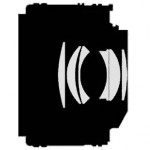 The image with the optical circuit is clickable. Lens version MKI и MKII use the same optical design. The image with the optical circuit is clickable. Lens version MKI и MKII use the same optical design. |
| Lens hood | Rubber hood Nikon HR-2. The lens hood is not included in the scope of delivery; the lens hood is screwed into the thread under the filters. |
| Transportation | Using the CL-S1 or CL-0715 soft case or using the CL-30S case. A case or case is not supplied and must be purchased separately. During transport, use standard rear (e.g. LF-1 or LF-4) and front (e.g. LC-52) covers. Usually sold with a white plastic translucent back cover. and black front. The lens is sold in a classic Nikon golden box (there are several modifications of the box design). |
| Period | from February 2002 to the present |
| Manufacturer country | Made in China (all MKIII lenses are made in China) |
| Instructions | See |
| 3D view | See |
| Price |
Nikon 50mm 1: 1.8D AF Nikkor (MKIII) - very lightweight lens. It has the smallest weight in its class. Due to its very small size and low weight, you can always take it with you. And finding a 52 mm filter is as easy as shelling pears. I really love hikesand every extra 100 grams of weight is a serious challenge, so instead of some heavy zoom lens I often use the Nikon 50mm 1: 1.8D AF Nikkor.
Nikon 50mm 1: 1.8D AF Nikkor smallest autofocus lens from Nikon that I have ever seen. There is a joke that it is in the pocket of every photographer. Just a joke, but I often keep Nikon 50mm 1: 1.8D AF Nikkor in my case, it takes up little space and I don't mind losing it.
Nikon 50mm 1: 1.8D AF Nikkor - one of the cheapest (if not the cheapest) fast fixed lens from Nikon. It is hard to find something cheaper. The lens will allow you to get the necessary experience for a little money when working with high-aperture optics, including fixed lenses. I almost always recommend the Nikon 50mm F / 1.8D AF as the first optional lens.
Nikon 50mm F / 1.8D AF can open the aperture up to f / 1.8. For example, an aperture ratio of 1: 1.8 is about 10 times morethan 1: 5.6. For example, class lenses 18-55/3.5-5.6 with the same focal length have 1: 5.6. F / 1.8 will allow you to shoot at low ISOs in low light conditions, use short excerpts when shooting handheld, and will also allow better control GRIP.
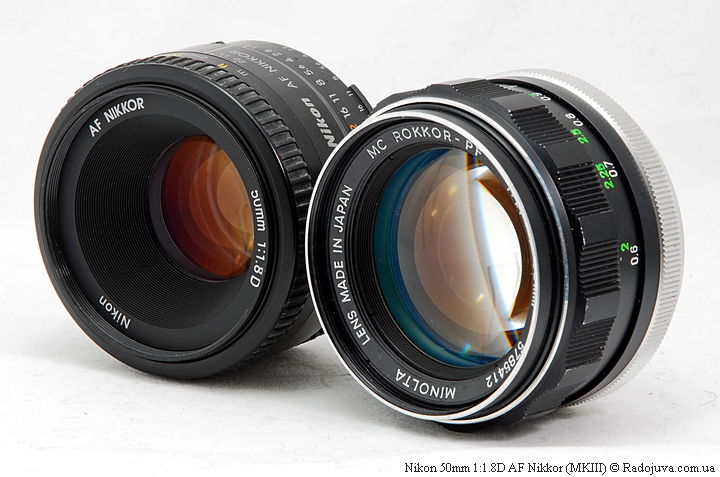
Nikon 50mm 1: 1.8D AF Nikkor (MKIII) and Minolta MC Rokkor-PF 1: 1.4 f = 58mm
Nikon 50mm F / 1.8D AF is very affordable lens, it is easy to find it in any store in any city. A huge number of copies of this model were released. Nikon 50mm f / 1.8D AF lenses are available with 2002 to this day.
It's a shame, but all Nikon 50mm 1: 1.8D AF Nikkor (MKIII) lenses are made in China. And here are his predecessors Nikon AF Nikkor 50mm 1: 1.8 (MK I) и Nikon AF Nikkor 50mm 1: 1.8 (MK II) produced in Japan.
The lens has fast auto focus system - on my camera, the lens focuses from 45 cm to infinity and back in one second. The most interesting thing is that his motorized brother Nikon AF-S Nikkor 50mm 1: 1.8G SWM Aspherical has exactly the same focusing speed. I tested both lenses together. Plus, the Nikon 50mm f / 1.8D AF focuses even faster than the flagship half a ruble - Nikon AF-S Nikkor 50mm 1: 1.4G.
Attention: the fact that the small Nikon 50mm 1: 1.8D AF has no built-in focus motor has nothing to do with focusing speed.
It's important: auto focus with this lens is available only when using him on cameras with built-in motor focusing.
Exact list Nikon DSLR cameras with a built-in focus motor, on which this lens will focus automatically:
- D1, D1h, D1x, D2x, D2xs, D2h, D2hs
- D3, D3x, D3s, D4, D4s, D5, D6
- Df
- D50, D70, D70s, D80, D90
- D7000, D7100, D7200,D7500
- D100, D200, D300, D300s,D500
- D600, D610, D750, D780
- D700, D800,D800E, D810, D810a, D850
- Fujifilm FinePix S1 Pro, S2 Pro, S3 ProS3 Pro UVIR, S5 ProIS Pro
- Kodak DCS PRO 14n, DCS Pro SLR/n
Exact list Nikon DSLR cameras without a built-in focus motor, on which this lens will not focus automatically:
Only auto focus and sound confirmation of focus will not work with these cameras, all other important functions, such as automatic exposure metering and automatic iris control, will work well.
You will find a lot of useful information on the types of cameras and lenses Nikon here.
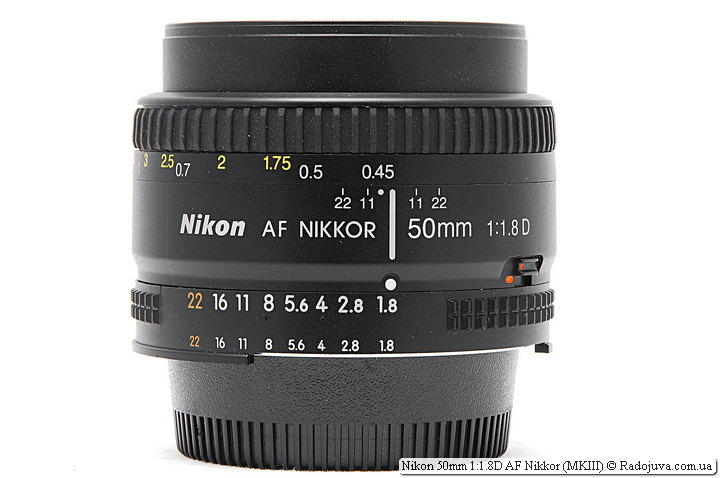
Nikon 50mm 1: 1.8D AF Nikkor (MKIII) while focusing at the minimum focusing distance (trunk extended as far as possible)
Attention: the lens has a manual aperture ring. To be able to control the value aperture from camera or for automatic installation aperture on modern central control valves, you need to turn the control ring to the F / 22 value (the value is colored in orange) and fix it with a special lever, which is located to the right of the marks aperture. If this is not done, then on a number of cameras, the display will display an error - 'fEE' (ring is not installed aperture) Some cameras having diaphragm rheostatallow you to control the diaphragm with this ring aperturebut only in metering modes exposure 'M' and 'A'. You can read more about this issue in the section on Non-G Lenses. Ring aperture rotates with clicks, the values F / 1.8, 2.8, 4, 5.6, 8, 11, 16, 22 are plotted on it, it is impossible to establish an intermediate value between pairs of numbers. This ring is useful, for example, for reverse macro shot.
Nikon 50mm F / 1.8D AF has focus distance scale. The scale is available in meters and feet, it is very nice and useful. For example, you don’t need to think in which direction the focus ring is rotated, just look at the lens for this. For example, a whale lens Nikon 18-55mm 1: 3.5-5.6GII VR II AF-S DX Nikkor It has neither a focus distance scale, nor a depth of field scale, nor an aperture control ring.
Nikon 50mm F / 1.8D AF has the ability to work on full frame the camera and is a Nikon FX type lens. On the Nikon DX cameras his EGF will be 75 mm. More details about FR and EGF in the section about 'crop factor'.
Nikon 50mm F / 1.8D AF has bayonet mount metal back... This is great news as many people think that the Nikon 50mm f / 1.8D AF is very lightweight and is made out of plastic.
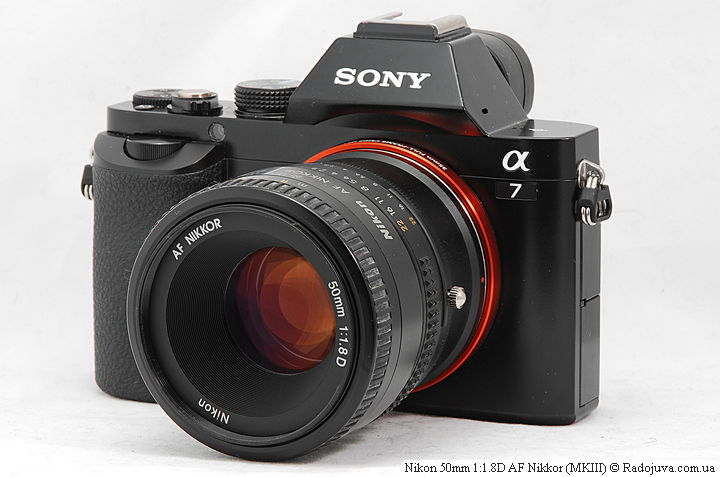
Nikon 50mm 1: 1.8D AF on camera Sony a7. The aperture control ring allows you to use the lens on any camera through the appropriate adapter.
When focusing front lens does not rotate. This allows you to easily use different filters and not worry about their shifts when focusing. The focus ring is rubberized and rotates 120 degrees, but in order to slightly shift the focus ring, you need to 'tear it off'. At the same time, smooth focusing is lost, since after such a “jerk” the ring flies over the desired value. The effort is not so great, but when working in macro mode, where, due to the very small depth of field, each degree of rotation plays a huge role, this “slightly twitchy” method of focusing greatly inflates the nerves during manual focusing. There is a similar effect on many other lenses, most pronounced on the 'dark' Nikon ED AF-S Nikkor 24-120mm 1: 3.5-5.6G SWM VR IF Aspherical. Nikon 50mm 1: 1.8D AF Nikkor users who always shoot with autofocus will most likely never notice the effect described above. Also, it is worth noting that the previous version of this lens, namely Nikon AF Nikkor 50mm 1: 1.8 (MKII, MIJ version)had no such problem.
Lens disadvantages:
- When using Nikon 50mm F / 1.8D AF lens on open apertures it is very difficult to achieve a sharp image... True, I noticed such a feature that sharpness disappears at apertures from F / 1.8 to F / 2.8. At f / 2.8-f / 8.0 aperture, the lens becomes very sharp.
- Nikon 50mm f / 1.8D AF pretty makes a lot of noise during auto focus. When you miss focusing, the lens buzzes annoyingly, and the camera motor scares small insects and nervous people, betraying the photographer in a quiet environment. Noisy autofocus has a very negative effect when shooting video.
- Nikon 50mm F / 1.8D AF does not have a built-in focus motor. As mentioned at the beginning of the article, it can be used with autofocus only on cameras with a focusing motor.
- There is no hood included with the Nikon 50mm F / 1.8D AF. The hood is attached by screwing it into the filter thread.
- When focusing, the entire lens block moves, while the 'lens trunk' extends forward.
- On the lens no focus mode switch, the transition to manual focus and back is carried out by means of a switch on the camera, which is located near the camera mount.
- The lens has a total of 7 non-rounded aperture blades that create 'nuts' in the out-of-focus area.
- The Nikon 50mm F / 1.8D AF is well built, but over time, a slight play in the focusing ring appears. If you shake the lens slightly, you can hear the tapping of the focusing ring. This is not a problem, just a small specific flaw.
With all the pros and cons Nikon 50mm 1: 1.8D AF Nikkor - an indispensable lens in all situations. For me personally, it is inconvenient in that the auto focus on my camera does not work Nikon D40which I often use. On the open aperture, the sharpness zone is very small and it’s very difficult to manually enter it.
All photos in the gallery below are shot on a Nikkor 50mm 1.8D AF and full-frame camera. Nikon D700 FX, photo without processing, only the size is reduced to 3MP and data from EXIF.
The gallery below shows photos from Nikon 50mm 1: 1.8 AF Nikkor NJ (NIKON JAPAN, MKII) without treatment:
Jpeg source photos download from this link (1.09 Gb). The archive is 453 photosfilmed in 6 months on Nikon D70. Oddly enough, but I enjoy working with this old and very cheap Nikon D70 both old and very cheap Nikon 50 / 1.8... The camera cost me $ 50, the lens - $ 90. On a 6 MP CCD sensor, even at F / 1.8, acceptable sharpness is obtained. I did not regret the shutter and filmed as much as my soul wanted. Photos from this collection are used by me in an article about choosing a Nikon DSLR. Examples of photos with processing can be found in my gallery here. You can see more examples of photos on Nikon 50mm 1: 1.8D AF Nikkor (MKIII) in the review Nikon D300 и Fujifilm FinePix S5 Pro и S1 Pro.
And also this link You can see my gallery of pictures obtained with the help of an old man Nikon D100 (Nikon's first digital SLR camera in a classic case) paired Nikon AF Nikkor 50mm 1: 1.8 (MKII, MADE IN CHINA).
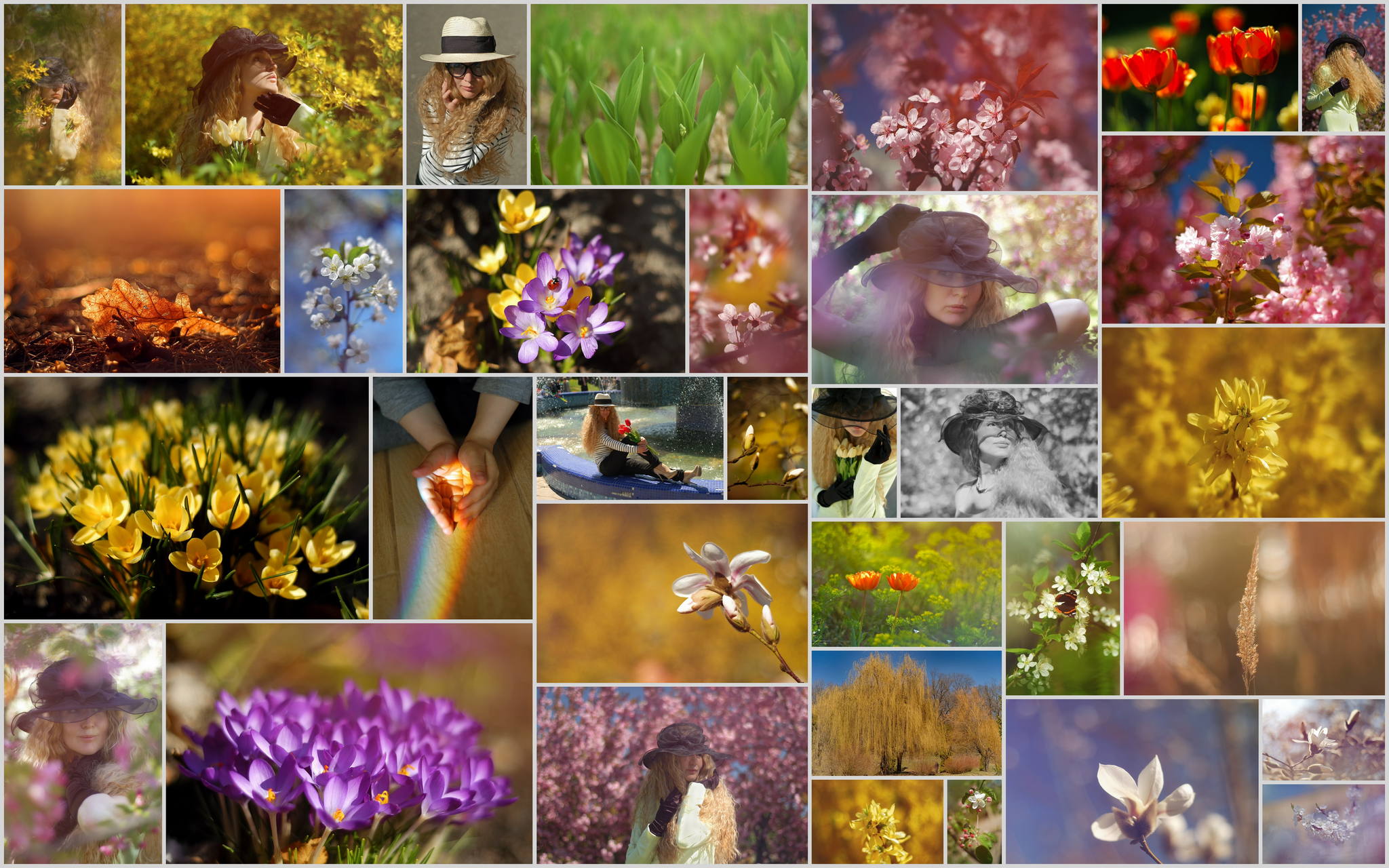
All pictures were taken with Nikon AF Nikkor 50mm 1: 1.8, MKII version, MIC (MADE IN CHINA) и Nikon D100. Enlarge Image or go to the gallery with large format photographs.
Video review
Short video review Nikon 50mm 1: 1.8 AF Nikkor NJ (NIKON JAPAN, MKII) you can see on my channel here.
Fifties Recommendations for Nikon Cameras
A list of all-all Nikon Nikkor autofocus lenses, as well as my recommendations for choosing the best option for specific tasks, can be found in the 'All Nikon autofocus fifty dollars'.
My experience
I really love the Nikon 50mm 1: 1.8D AF Nikkor. This is my first autofocus fast aperture lens, which I used in a wide range of photo tasks and spent a huge number of shoots with it.
As a result, Nikon 50mm 1: 1.8D AF Nikkor is:
- The easiest original full frame fixed focus lens with auto focus
- The cheapest Original fast prime lens with auto focus
- Most affordable Original fast prime lens with fixed focal length and auto focus in the secondary market. Countless instances of it have been released.
- The most compact original fixed focus lens with auto focus
- One of the fastest original autofocus lenses for FX and DX cameras (brighter only ten lenses with f / 1.4Unfortunately Nikon does not release aperture optics for FX cameras with support for autofocus)
- One of the best price / quality lenses
A huge number of lenses from Nikon (hundreds of models) passed through my hands. In my personal opinion, the Nikon 50mm 1: 1.8D AF Nikkor is one of the best lenses of all time from Nikon.
Lens prices
Real prices for the lens in popular online stores can see here, or in the price block below:
Also, this lens can be found on:
- Look at Power outlet
- Look in Connected
- Look at E-Catalog
- Look at Magazilla
- Look at M.Video
- Look at Ozone
- Look at Nadavi
- Euroset
- On the AliExpress
Comments on this post do not require registration. Anyone can leave a comment. Many different photographic equipment can be found on AliExpress.
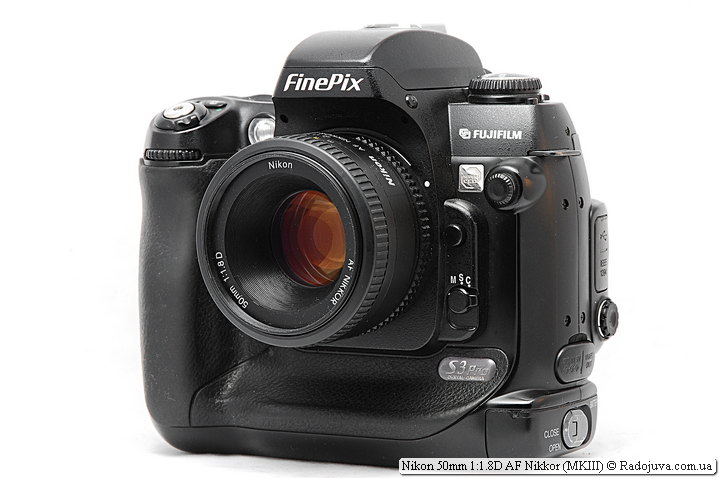
Nikon 50mm 1: 1.8D AF Nikkor on camera Fujifilm FinePix S3 Pro
Results:
Nikon 50mm 1: 1.8D AF Nikkor (MKIII) - great lens for the money... Due to its compactness and lightness, the Nikon 50mm 1: 1.8D AF Nikkor (MKIII) can always be taken with you. It can produce very sharp images with slightly rough bokeh. On DX cameras it can be used as a conventional portrait lens. The lens' only serious drawback is the lack of sharpness at apertures from F / 1.8 to F / 2.8.
UPDATE: in 2016, a Chinese lens appeared, based on the Nikon 50mm 1: 1.8D AF Nikkor optical circuit (optically no worse) and with an integrated focus motor. See YONGNUO 50mm 1: 1.8 review (YN50mm F1.8N).
Material prepared Arkady Shapoval. Training/Consultations | Youtube | Facebook | Instagram | Twitter | Telegram

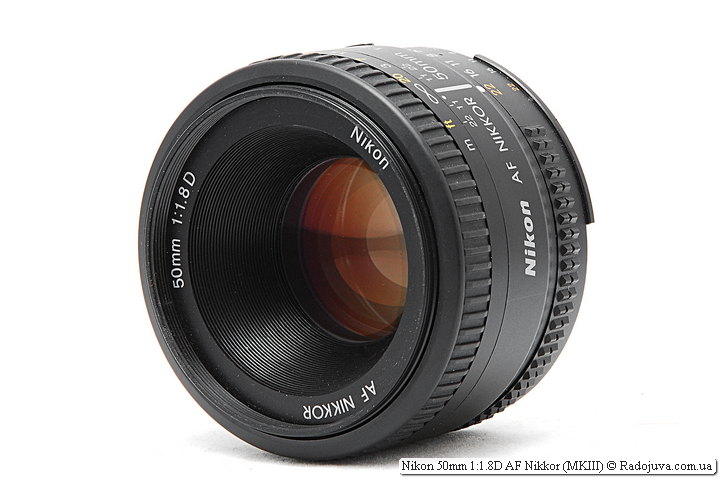
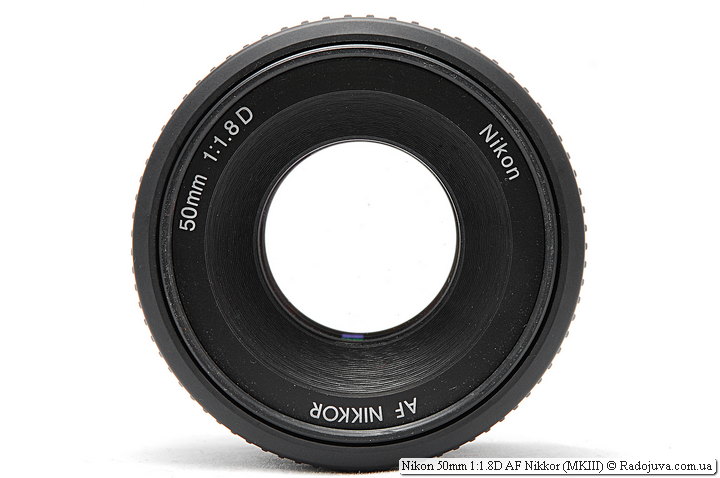
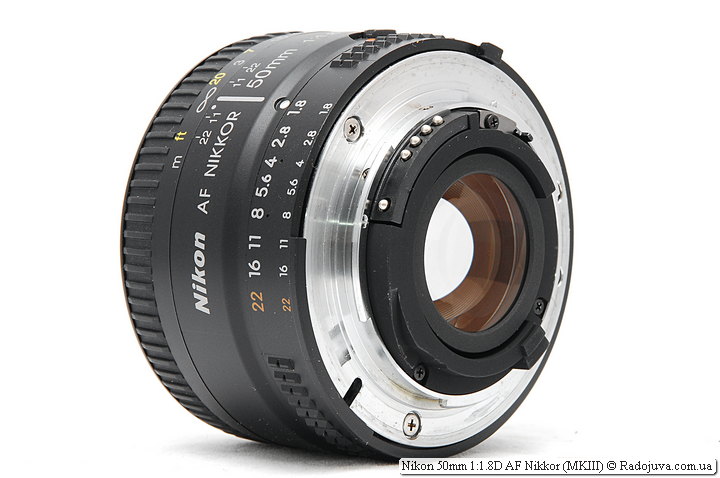
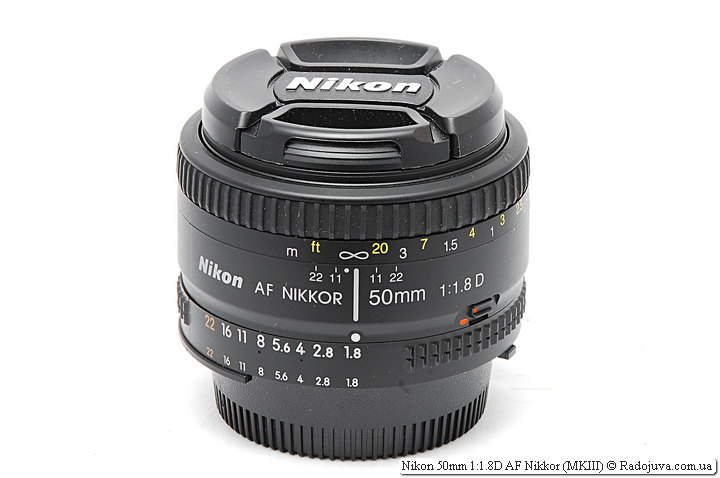
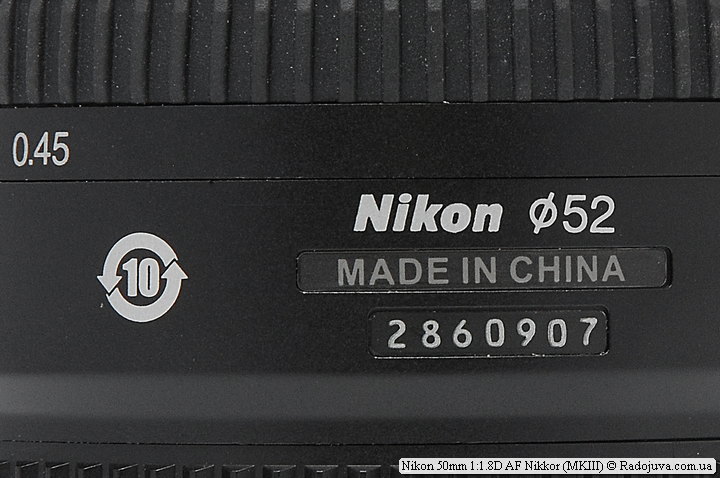

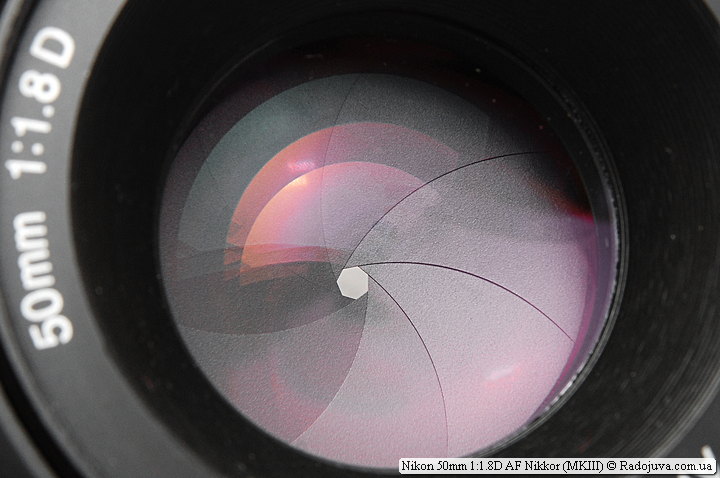

























































































































Good evening Arkady, in the review about the lens I did not see photos of landscapes. Sobsno question: I myself bought this lens for portraits, it seems there are no questions, but the landscapes in my opinion are obtained either in soap or in shake. There is not enough sharpness at infinity. That is, it is sharpness but insufficient. I set the aperture to 5,6-11. Is this a lens marriage or feature?
It may be the marriage of your lens. He normally copes with landscapes.
Please tell me Acradius.
Now I have 18-105 Nikor, 100 / 2.8 Kaleinar, and I want to buy a fixed “fifty kopeck piece”.
What is better to buy (for portraits and indoor shooting), having a D7000 camera - Nikor 50 / 1.8 or Gilius 81H?
Gelius 81H is good, but it has only manual focusing, Nikor 50 / 1.8 has autofocus with D7000, but it has a working “hole” with 2.8
It all depends on the shooting conditions, where you need dynamics, you need autofocus.
Hello Arkady
I have the same problem with the lens
Only 22 can be placed on the lens aperture, and everything else cannot. Writes "FEE" on the screen and does not remove
What to do ? Can a lens defect?
I remembered another plus of Nikor 50 / 1.8D - the ability to transfer the focusing distance to the camera, which simplifies the work with an external flash. This is a decisive plus when choosing a lens. (in my case)
You need to install F / 22, and switch the special lever on the lens. Then everything will be fine.
Hello Arkady
I have a problem with the lens
You can put only 22 on the lens aperture, but everything else is not. Please tell us how to adjust the lens so that the ring on the lens is fixed at other values, and not only at 22.
Set the value on the F22 lens and switch the special lever on the lens. After which the diaphragm will control from the camera.
But why then on the ring switch with a latch?
For film cameras, in more detail in the section https://radojuva.com.ua/2012/03/nikon-lenses/
Good afternoon!
I do not agree with your opinion that the lens is unsharp in the range 1.8-2.8. About five 1.8D lenses passed through me and everything was sharp starting from 1.8, and from 4 there was already razor sharpness. The 50 1.4D lens, on the contrary, softs open and is compared in sharpness with 1.8D only with aperture 2.8 This is also confirmed by the MTF chart: http://www.photozone.de/nikon–nikkor-aps-c-lens-tests/216-nikkor-af-50mm-f14-d-review–lab-test-report?start=1 , http://www.photozone.de/nikon–nikkor-aps-c-lens-tests/217-nikkor-af-50mm-f18-d-review–test-report?start=1 , which is why I abandoned 1.4D
Good evening Arkady, I would very much like to hear your advice: is it worth taking this lens or can it pay extra and take 1.4 with a hole? I don’t earn in the photo, it’s a purely hobby.
and a little out of topic…. What can you say about Nikkor 35-135 mm 3,5-4.5 or maybe better buy 18-105?
Thank you in advance.
With uv. Yuri
Honestly, I have never seen Nikkora 35-135, maybe they confused me with something. It’s better to pay extra and take 1.4G, since this is the limit for aperture ratio and nothing more will be wanted.
yes no- here is the link to Nikkora 35-135 photo http://i40.fastpic.ru/big/2012/0927/a0/6d69bd7284126e0ef4eadd64ba619ea0.jpg Got it - I take with 1.4 fifty
Good afternoon, Arkady. Thank you very much for your site! Recently I bought this lens (AF version, since I have a D90 with a screwdriver), everything is functional, but the build quality is lame ... I bought it new, but from the first days the focusing ring dangles in it (when the camera moves sharply from side to side, not along the direction of the ring, but "perpendicular"). The focusing itself is rather tight, as you wrote above. Written to be made in China. Is this just my problem or is it for everyone?
Once at a time do not have to. I have been in my third year and everything is fine.
Good evening, tell me at 7000 whether auto focus will work or not ??? and what’s better to get af or af for nikon 7000
Yes, it will work. It is better to take modern AF-S lenses.
I bought a 50mm 1.8 D as the first lens for my first D90 DSLR. And to be honest, I was very upset ... the pictures were not sharp, even with manual focusing. It turned out not at all what I saw in other people's photos in the net. I began to sin on a defective carcass, a bad lens, on my crooked hands growing out of my ass ... It turned out to be much more prosaic, I just always shot at the maximum open hole 1.8 in order to reduce the shutter speed, fearing shake. And quite recently, in the course of experiments, I found out that sharpness begins to appear only from an aperture of 2.8 or more))) And today I read this article too ... oh, where have you been before)) but thanks anyway for the site and articles!
It's my pleasure :)
Thanks to the site and everyone who takes part in the discussions! I’ve read everything and acquired this lens, I’m extremely happy! after 18-55 exactly what I expected from the SLR! thank you very much!
Congratulations on a successful purchase.
Tell me, is there a difference if you take into account the manufacturer (for example, made in Japan, or only in Japan they are made)?
Well, the difference in the letter .. D and without it ... Thank you for earlier!
I make them not only in Japan. Regarding the difference with D and without D, I have described in detail here - https://radojuva.com.ua/2012/03/nikon-lenses/
Is there any difference in what it produces, complaints about the work of, for example, Chinese, etc.?
I did not observe the difference.
Greetings!
Tell me, will it be difficult to catch the focus manually on the Nikon 3100?
With uv.Vladimir!
It all depends on work experience. For example, it’s not difficult for me, first I will need to practice.
Thank you! The last six months I’ve been shooting only in M mode and try to use manual focus on the 18-55 kit. I think I can handle it)
Hello, I bought this lens, and I can't figure it out ... How to manually set the aperture?
When I remove the aperture lock and set the ring to a value less than F22, the camera writes fEE
Tos gives an error.
Nikon D200 / Camera
Thank you in advance!
You need to set the value to 22, click the aperture mode switch. The aperture is switched on the camera in A, M mode using the front selector.
Nothing happens .... The camera gives an error ... I set the aperture value manually (with a ring) less than 22 and the display shows an error.
I repeat, the aperture on your camera Nikon D200 must be installed on the camera, and not on the lens. On the lens, the aperture ring should be at a value of 22 and the locked switch near the aperture ring.
I know that…. I mean, is it possible to set the aperture on this lens as on manual optics, by means of a ring on the lens, and not control with the help of the camera ..?
It is possible, but only film cameras will work adequately.
Tell me, can you turn the focusing ring somehow manually ??? I saw a guy on YouTube turns it without any problems, but I have no problem ... I just got the lens.
Thank you!
For manual focusing, you need to switch the lever to the M position on the camera, otherwise you risk severely damaging the focus motor in the camera.
Thank you so much, figured it out !!!
Happy for you. I wish you good shots!
I wonder how he behaves with macro rings as a macro lens.
Not used in this mode, I can not tell.
but it is worth buying it for the Nikon D5000
depending on what purpose, it will not automatically focus on it.
Arkady, a very useful article!
Please tell me, I do not understand cameras at all, I'm going to take the Nikon D3100 body, and such a lens is for it. It turns out there will not be autofocus, I understand correctly?
Is it difficult to direct it manually? I’m just buying for shooting a small child who is not sitting still. Is it advisable to take without autofocus? Thank you in advance.
Hello. Not advisable, it is better to take with a lens Nikon 35mm f / 1.8G AF-S DX Nikkor or with Nikon 50mm f / 1.8G AF-S Nikkor
Hello, Arkady! I have such a question, you wrote "It is better to take modern AF-S lenses." why then “screwdriver” in the carcass? Is the 50mm f1 / 8G better than the 50mm f1 / 8D? And another question, I see little optics without a motor, but where can I buy it or only used?
In the general case, G lenses are better than D, as simply G is simply newer. Yes, the Nikon 50mm f / 1.8G AF-S Nikkor will be a little better than the Nikon 50mm f / 1.8D AF Nikkor, in general, the 1.8G is the only fifty dollars using aspherical elements. There are a lot of optics from a screwdriver, I would say it is just a huge amount, including from third-party manufacturers. Indeed, many lenses are available only B.U. But many do not even have motor versions, for example 105 / 2.0 AF, 135 / 2.0 AF, 180 / 2.8 AF.
I will sell in perfect condition Nikon 50mm 1.8D (067) 725-97-75
Sold